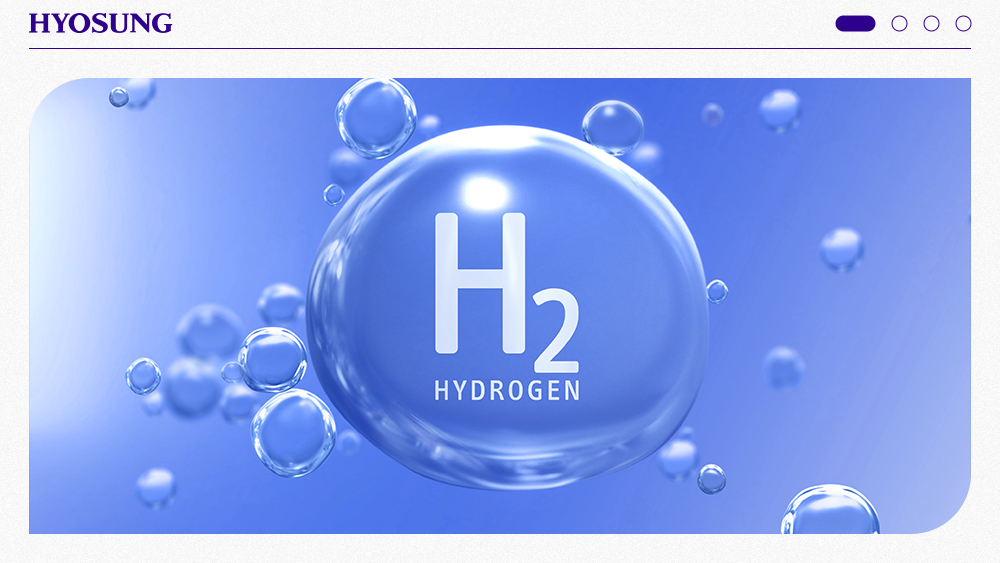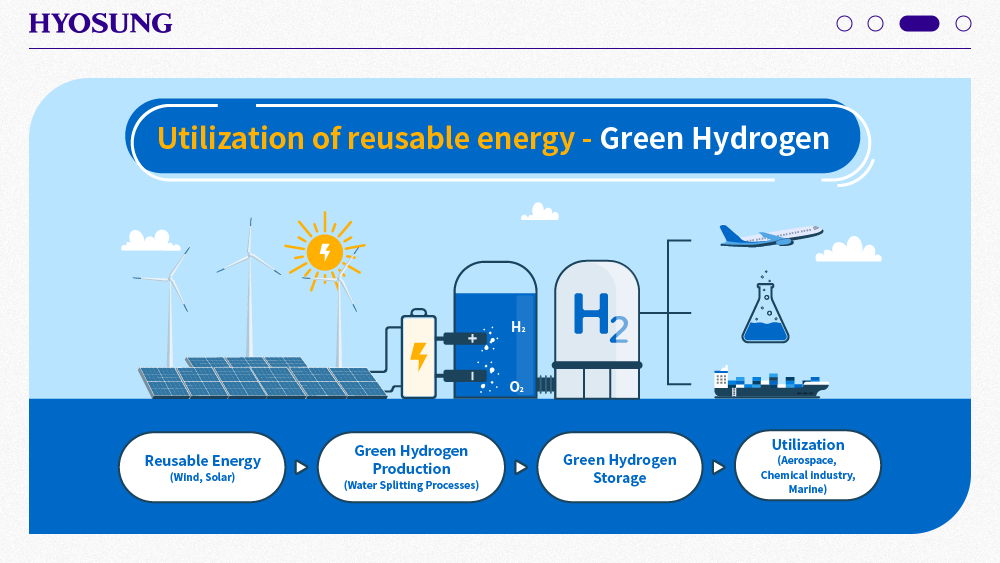Hyosung, Shaping a Hydrogen Economy for Korea
2023.06.24
Recently, environmental issues have emerged as a pressing concern for human survival as the world experienced abnormal weather patterns. In response, many nations have declared carbon neutrality, aiming to reduce their reliance on carbon-emitting fossil fuels. This has sparked an increasing interest in renewable energy sources. Hydrogen, inherently an energy source itself, has also gained attention for its role as an energy storage device, effectively converting generated renewable energy for use.
In the past, hydrogen was a challenging energy form to produce, store, transport, and utilize. However, recent advancements in science and technology and innovative materials like Hyosung's carbon fiber, TANSOME®, have solidified hydrogen's standing as a future energy source. Hyosung is the company shaping a society that embraces hydrogen as future energy, creating the value chain of hydrogen and building our nation's hydrogen economy.

Hydrogen, From Hot Topic to Mainstream Issue
Element number 1, 'Hydrogen,’ was created by the Big Bang approximately 13.8 billion years ago. Its existence was first recognized by British scientist Henry Cavendish in 1766 and was later coined 'hydrogen' by Antoine-Laurent de Lavoisier of France. Known for its propensity to burn rapidly, efforts to harness its potential have been consistent. Interestingly, French novelist Jules Verne predicted in his 1874 novel, 'The Mysterious Island,’ that hydrogen obtained by splitting water would become the 'coal of the future.’
While the idea of using hydrogen as an energy source has been around for a long time, it was often considered unfeasible due to the inability to convert hydrogen into energy. This was due to a lack of technology to produce usable hydrogen and materials to properly store the produced hydrogen. Until a few years ago, hydrogen-powered cars seemed a distant prospect. However, a new era s beginning that utilizes hydrogen as a significant energy source has as we enter an era capable of exploiting its potential.

Does Hydrogen Have a Color?
While hydrogen is indeed colorless, odorless, and tasteless, it has been assigned different colors based on its production methods. As hydrogen is a clean fuel that doesn't emit carbon when used as an energy source, it's preferable that it also does not emit carbon during its production process. Hence, the produced hydrogen is classified and graded as 'Grey Hydrogen,' 'Blue Hydrogen,' and 'Green Hydrogen.'
Grey hydrogen is derived from byproducts of petrochemical processes, the steel-making process, or from the reformed hydrogen of the decomposition of natural gas under high temperature and pressure. However, these processes generate more carbon than hydrogen, making it insufficient as an eco-friendly alternative energy source.
Blue hydrogen is produced in the same way as grey hydrogen, but the carbon generated during the production process is captured and stored using Carbon Capture, Utilization and Storage (CCUS) technology, preventing its release into the atmosphere. This stored carbon can be used in the production of various materials. Given that it does not emit carbon into the atmosphere, it is considered the most practical method currently.
Green hydrogen is produced by splitting water molecules into hydrogen and oxygen using electricity from renewable sources such as solar or wind power. This process doesn't produce any carbon, making it the ideal way to produce hydrogen. However, barriers to this approach exist due to the lack of sufficient renewable energy and electrolysis facilities.
The goal of the world, and Hyosung, is to freely utilize green hydrogen in daily life, but there are still many challenges to be addressed in terms of technology, cost, environment, and infrastructure. Blue hydrogen will act as a bridge to carbon neutrality until sufficient green hydrogen can be secured, and Hyosung is developing CCUS technology to realize this and turn grey skies blue. Of course, there is also a vision for green hydrogen.

Hyosung's Pursuit of Green Hydrogen
Hyosung strives to generate green hydrogen, leading the market with its superior domestic know-how in renewable energy, which is vital for its production. Hyosung spearheads wind turbine development, harnessing its expertise in creating and designing essential components like gearboxes and generators. Initiating the successful development of the country's first 750kw wind turbine, Hyosung is now vigorously pursuing KS certification for a 10MW class offshore wind turbine.
Hyosung’s wind turbines, equipped with larger blades compared to equivalent models, yield an elevated annual power generation and profitability, particularly optimized for Asia's low wind speed in offshore regions. The turbines are designed to withstand extreme wind speeds caused by severe typhoons, ensuring operational stability and reliability in the domestic environment. User convenience isn't overlooked, including nacelle cranes, considering maritime conditions, enhancing operational and maintenance convenience, reducing operating costs, and increasing uptime even without offshore cranes.
Hyosung's wind turbines, thus produced, are employed in wind power plants located in Gangneung, Pyeongchang, and Taebaek of the Gangwon region, as well as Kimnyeong and Gasiri of Jeju. Looking ahead, Hyosung plans to invest 1 trillion KRW in establishing an offshore wind power assembly plant in the Jeonnam region to construct a green hydrogen production system utilizing renewable energy. Particularly from this year, the company is propelling the construction of the country's largest scale 10MW class electrolysis facility, planning to increase the annual green hydrogen production to 200,000 tons.
Hyosung is also at the forefront domestically in the Energy Storage System (ESS) sector, an essential facility for stabilizing renewable energy output. The ESS stores electric energy when the usage is low and supplies it when needed, contributing to energy utilization efficiency, enhancing renewable energy usage, and stabilizing the power supply system. Hyosung handles everything from system supply to maintenance and consulting for construction in the ESS business, possessing a responsive capability to potential issues that could arise during project execution and deploying specialists in every segment. Leveraging expert personnel and systematic systems, it swiftly responds to system stability and system failures, improving reliability. With its wealth of business experience and product reliability, Hyosung holds a unique advantage in the ESS business, contributing to maximizing customer value and creating new future value in the power industry. Hyosung is committed to launching a true era of green hydrogen.

Hyosung’s Hydrogen Economy Society
Despite the doubt when no one could easily predict whether a world utilizing hydrogen energy would become a reality, whether hydrogen vehicles would be commercialized, or whether hydrogen fueling stations would emerge, Hyosung consistently prepared for the hydrogen era, covering 'production-storage-transportation-supply-use' of hydrogen.
In partnership with the Linde Group, Hyosung produces liquid hydrogen at the world's largest liquid hydrogen plant, located in Ulsan Yongyeon. Hyosung Advanced Materials' TANSOME®, a core reinforcement material for hydrogen vehicle fuel tanks, enables safe hydrogen storage and is applied to hydrogen fuel container reinforcements during transportation.
Hyosung is also the leading company in market share for hydrogen fueling stations, where consumers encounter hydrogen fuel. Hyosung has expanded the number of hydrogens fueling stations nationwide to over 30 and plans to further increase both gaseous and liquid hydrogen fueling stations. Essential high-pressure vessels for hydrogen vehicles are also manufactured utilizing the strengths of TANSOME®, which possesses high-strength characteristics. High-pressure vessels made with TANSOME® contribute to improved fuel efficiency and reduced emissions by being lighter than conventional materials.
Hyosung, having designed the core value chain encompassing all processes from hydrogen production to storage, transportation, supply, and use, is leading the paradigm shift toward hydrogen energy through continuous investment. Hyosung, a next global leading hydrogen energy company, invites you to delve into its pioneering efforts to shape South Korea's hydrogen economy.